Clash of Clans - game time monetization mechanisms
- Transfer

In Clash of Clans (Supercell’s super-popular multiplayer game), players can accelerate various actions, for example, building structures, upgrading and training troops using gems that are purchased for real money. In other words, developers earn on the impatience of players, which is typical of all multiplayer games in general, where you need to build something.
That's why we decided to study the work of formulas that control game mechanics and find out what the price of time in CoC is.
Let's start by comparing several graphs.
This line graph shows the cost of skipping a particular period of time in gems. More time - more gems, no wonder.
But there is a trick. It seems that the price is growing exponentially, but it is not at all! This is because the difference between 60 seconds (1 minute) and 604800 seconds (1 week) is too large. Time grows exponentially, and this distorts the data.
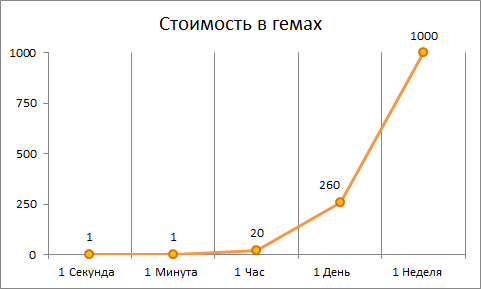
The scatter plot gives a more reliable picture. A uniform scale is chosen on the horizontal axis, but in the lower left corner the graph is difficult enough for interpretation. The points are too close to be distinguished.
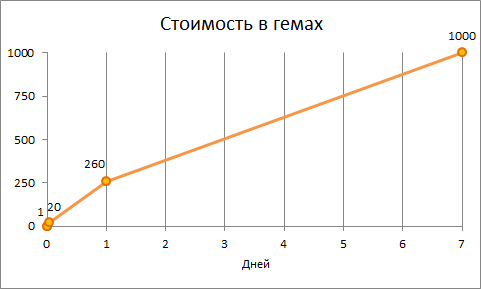
Let's try a different way of presenting data. We will understand them as the cost of a 1 second pass. The more time you miss, the more you pay, but the deal becomes more profitable. You can take it as a growing discount.
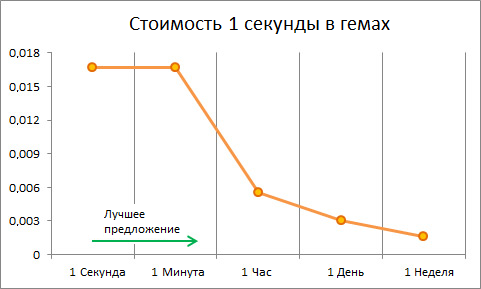
Testing showed that such a graph consists of several linear segments and is not an approximation of a curved graph. This will be explained in more detail later.
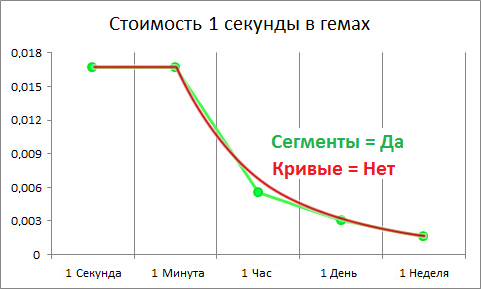
Now let's turn to the formulas.
To begin with, we will collect the prices of interest to us in a table, and then we will show how to calculate any other price using linear interpolation.
| Time | Time in sec. | Price in gems |
| 0 seconds | 0 | 0 |
| 1 second | 1 | 1 |
| 1 minute | 60 | 1 |
| 1 hour | 3,600 | 20 |
| 1 day | 86,400 | 260 |
| 1 Week | 608,800 | 1,000 |
Very elegant system: dividing the price in accordance with significant intervals for people (hour / day / week) makes it very understandable. It is easy for everyone to imagine what it means to wait, for example, for one day. In addition, this system is very easily reconfigured - if it is subsequently decided to increase the cost of one day, it is enough to change only one value.
And the most interesting thing about using a chart consisting of linear segments is the ability to set and use specific price points.
We turn to the formula, the graph of which we can build.
Let's start with a simple formula for constructing the equation of the line:

From here we get the equation of the line connecting two points
 and
and  .
. 
 , on the horizontal axis - time
, on the horizontal axis - time , on the vertical axis - gems.
, on the vertical axis - gems. Now we can calculate the values of the function. Based on the Clash of Clans data, suppose 1 hour (3600 seconds) costs 20 gems and 1 day (86,400 seconds) costs 260 gems. For a given line segment, a function can be defined.

With its help, you can calculate the cost of any period of time in the interval from 1 hour to 1 day. For example, to find out the cost of a 4-hour pass, we substitute
 and get it
and get it  .
. All formulas for individual linear segments can be combined into one large piecewise-defined function.

This is the formula for transferring gems to time, used in CoC.
To use excel, copy this long formula into cell B1. After that, enter the time in seconds in cell A1, and the value in gems appears in cell B1.
= ROUND (IF ($ A $ 2 = 0; 0; IF ($ A $ 2 <= 60; 1; IF ($ A $ 2 <= 3600; ((20-1) / (3600-60)) * ($ A $ 2-60) +1; IF ($ A $ 2 <= 86400; ((260-20) / (86400-3600)) * ($ A $ 2-3600) +20; ((1000-260) / (604800- 86400)) * ($ A $ 2-86400) +260)))); 0)
Try a clear demo version. Double-click on time to change it, and the value in gems will change.
Now let's talk about how this affects real money.
Before that, we only operated on the in-game currency Clash of Clans - gems. But they are purchased in the store for real money, so the price can also be indicated in them. Here is the Supercell price for gems.
| Gems | Price | Gems for £ | £ per gem |
| 500 | £ 2.99 | 167 | £ 0.0060 |
| 1,200 | £ 6.99 | 172 | £ 0.0058 |
| 2,500 | £ 13.99 | 179 | £ 0.0056 |
| 14,000 | £ 69.99 | 200 | £ 0.0050 |
The more you buy, the lower the price of one gem, but we will talk about these discounts later. In the meantime, we resort to simplification and use the average price: £ 0.0055 per heme.
This is very useful, as it helps to use the above formula for determining prices in real money. Supercell decided that a one-day pass to CoC would cost £ 1.43, and a 1-week pass would cost £ 5.49. If you need to change the price of 1 day, for example, to £ 2.00, just change this value, and all the rest will change automatically. This is a very convenient and reasonable way to control the monetization of the game.
Discounts
Buy gems
The sizes of sets of gems are set in advance. So, you cannot buy 501 gems and must either purchase a set of 500 gems or a set of 1200. Nevertheless, it seemed interesting to us to present this in a graph.
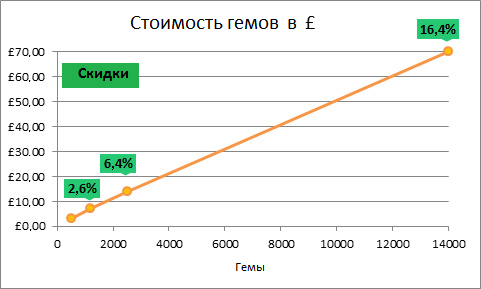
At first glance, this is not very noticeable, but with an increase in the number of gems, the line becomes more gentle. Supercell gives a discount if you buy more.
| Gems | Price | Gems for £ | £ per gem | A discount |
| 500 | £ 2.99 | 167 | £ 0.0060 | 0.0% |
| 1,200 | £ 6.99 | 172 | £ 0.0058 | 2.6% |
| 2,500 | £ 13.99 | 179 | £ 0.0056 | 6.4% |
| 14,000 | £ 69.99 | 200 | £ 0.0050 | 16.4% |
When you buy a set of 14,000 gems, you save 16.4% compared to the price of a set of 500 gems.
Skipping time
If we compare the discount on buying gems with the discount on skipping time, it becomes obvious that the discount on skipping a longer period of time is much higher than the discount on buying a larger set of gems.
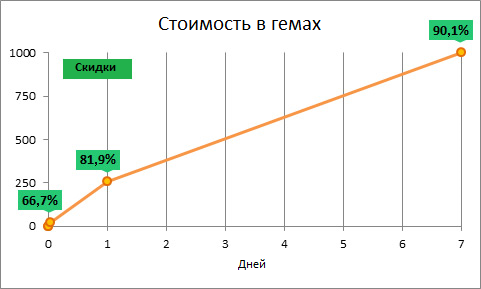
If you skip a week, you save as much as 90.1% compared to skipping 1 minute.
| Time | Time in sec. | Price in gems | Price (gems / sec) | Medium Price (£) | A discount |
| 0 seconds | 0 | 0 | 0.0000 | £ 0.0000 | - |
| 1 second | 1 | 1 | 0.0167 | £ 0.0055 | - |
| 1 minute | 60 | 1 | 0.0167 | £ 0.0055 | 0.0% |
| 1 hour | 3,600 | 20 | 0.0056 | £ 0.1098 | 66.7% |
| 1 day | 86,400 | 260 | 0.0030 | £ 1.4273 | 81.9% |
| 1 Week | 608,800 | 1,000 | 0.0017 | £ 5.4896 | 90.1% |
It is also important to note that the difference in the discount between 1 minute and 1 hour is 66.7%, and between 1 hour and 1 week only 23.4%. Instead of considering intervals longer than 1 day to be cheap, it makes more sense to consider small intervals of 1-59 minutes as being too expensive. Why it happens? We do not have a definitive answer ... it can be assumed that only the most impatient players, who are also the most inclined to spend money, will want to miss such small intervals. Perhaps there is some price discrimination. Be that as it may, we do not have a final answer, and we will be glad to any comments that can help!
Summing up discounts
If you buy gems and then spend them on skipping time, discounts are added up.
The most disadvantageous deal is to buy 500 gems for £ 2.99 and spend them skipping one minute. For every second you miss, you pay £ 0.000100.
The best deal is to buy 14,000 gems for £ 69.99 and skip 1 week. For every second you miss, you pay £ 0.000008.
The difference in price will be 91.7%.
| Worst deal | Best deal | ||
| £ per gem | £ 0.006 | £ 0.005 | |
| Price in gems | 1 | 1,000 | |
| Price £ | £ 0.006 | £ 5 | |
| Seconds | 60 | 604,800 | Difference |
| £ £ per second | £ 0.000100 | £ 0.000008 | 91.7% |
The power of discounts
Perhaps the price per second will seem insignificant to you, but when it comes to 604800 seconds, these small values are summed up. So, if you paid a 1-week pass at the same rate as a 1-minute pass, you would pay £ 60 instead of £ 5 !!!
A large discount on skipping long periods of time is very useful. Without it, prices would very quickly become too high, and no one would shop.
Probably, Supercell understood this well. They needed a way to give users a substantial discount on skipping large intervals, so that the system was easy to configure. The linearly segmented graph was an excellent solution to this issue.
Finally, let's look at alternative solutions.
There are other ways to solve the problem. Having examined them, we get a better idea of the pros and cons of the chosen method.
Line chart
Our first idea was to use a simple line chart. In this case, we would have a simple exchange rate, just like for currencies in the real world.
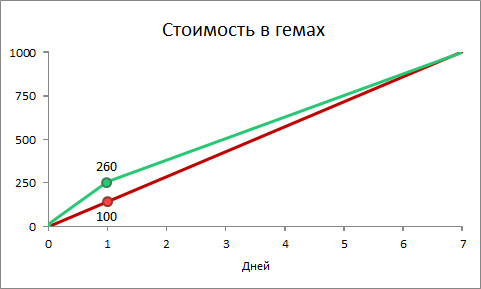
The application of this concept is possible, but the price of a 1-day pass will fall by 61.5% from 260 to 100 gems. And if we want to keep this price at the same level, the schedule will go better and the price of a 1-week pass will increase too much.
This mechanism allows tuning on only 2 points. Otherwise - which was probably considered by Supercell - several linear segments are needed. In theory, you can configure a larger number of points. So, if it were necessary to change the price of a 2-day pass, it would be enough just to add another linear segment.
Curved graph
Why not use a smooth curve? For example, an exponential, quadratic function or a Bezier curve?
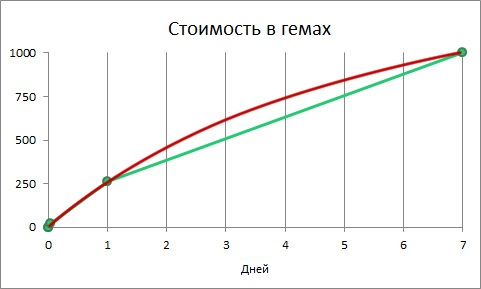
Everything looks very neat and smooth, but it is difficult to set up. Working with formulas requires too much effort. We spent a lot of time on this, and therefore we do not advise you to try it yourself.
Conclusion
Clash of Clans uses a very elegant way to monetize time passes. It is difficult to offer a more convenient system.
As a result:
- Skipping more time, you spend more money, but get the best discount.
- The graph illustrating the pricing algorithm consists of a set of linear segments.
- The advantage of using a linearly segmented graph is the ability to select and configure specific points in an easy to understand way.
- The discount for skipping a longer period of time is much higher than the discount for buying a larger set of gems.
- A large discount on skipping long periods of time is very important. Without it, prices would rise too quickly so that no one would make such purchases.
Any feedback, questions or comments? Leave a comment! This article is the result of the game in CoC and additional research. As far as we can tell, the data is accurate, and all the graphs and calculations have been carefully checked. Nevertheless, there is always the likelihood of a mistake, and in addition, the game itself may have changed since the publication of this article. We cannot give a 100% guarantee, so use the results at your own risk. If you find a mistake, please contact us.
